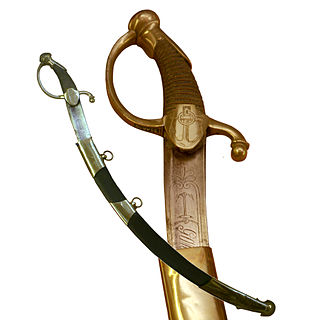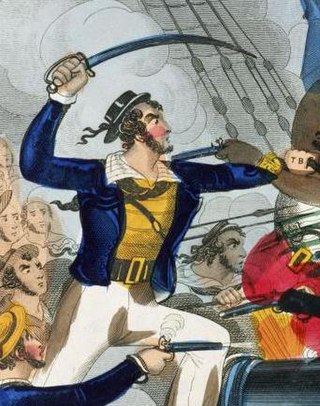A sword is an edged, bladed weapon intended for manual cutting or thrusting. Its blade, longer than a knife or dagger, is attached to a hilt and can be straight or curved. A thrusting sword tends to have a straighter blade with a pointed tip. A slashing sword is more likely to be curved and to have a sharpened cutting edge on one or both sides of the blade. Many swords are designed for both thrusting and slashing. The precise definition of a sword varies by historical epoch and geographic region.

The hilt is the handle of a knife, dagger, sword, or bayonet, consisting of a guard, grip, and pommel. The guard may contain a crossguard or quillons. A tassel or sword knot may be attached to the guard or pommel.

A sabre is a type of backsword with a curved blade associated with the light cavalry of the early modern and Napoleonic periods. Originally associated with Central European cavalry such as the hussars, the sabre became widespread in Western Europe during the Thirty Years' War. Lighter sabres also became popular with infantry of the early 17th century. In the 19th century, models with less curving blades became common and were also used by heavy cavalry.
This is a list of types of swords.

Dao are single-edged Chinese swords, primarily used for slashing and chopping. They can be straight or curved. The most common form is also known as the Chinese sabre, although those with wider blades are sometimes referred to as Chinese broadswords. In China, the dao is considered one of the four traditional weapons, along with the gun, qiang (spear), and the jian, called in this group "The General of Weapons".

The small sword or smallsword is a light one-handed sword designed for thrusting which evolved out of the longer and heavier rapier of the late Renaissance. The height of the small sword's popularity was during the 18th century, when any civilian or soldier with pretensions to gentlemanly status would have worn a small sword daily.

Swordsmanship or sword fighting refers to the skills and techniques used in combat and training with any type of sword. The term is modern, and as such was mainly used to refer to smallsword fencing, but by extension it can also be applied to any martial art involving the use of a sword. The formation of the English word "swordsman" is parallel to the Latin word gladiator, a term for the professional fighters who fought against each other and a variety of other foes for the entertainment of spectators in the Roman Empire. The word gladiator itself comes from the Latin word gladius, which is a type of sword.

The English language terminology used in the classification of swords is imprecise and has varied widely over time. There is no historical dictionary for the universal names, classification, or terminology of swords; a sword was simply a single-edged or double-edged knife.
Szabla is the Polish word for sabre.

The shashka or shasqua is a kind of North Caucasian sabre; a single-edged, single-handed, and guardless backsword. The comparatively subtle curve of a shashka blade puts the weapon midway between a typically curved sabre and a straight sword, effective for both cutting and thrusting.

The Pattern 1908 cavalry trooper's sword was the last service sword issued to the cavalry of the British Army. It has been called the most effective cavalry sword ever designed, although its introduction occurred as swords finally became obsolete as military weapons. In use, it, like other thrust-based cavalry swords, is best described as a one-handed lance, due to its complete lack of utility for anything but the charge. In fact, the closely related US Model 1913 Cavalry Saber was issued with only a saddle scabbard, as it was not considered to be of much use to a dismounted cavalryman. Colonial troops, who could expect to engage in melee combat with opposing cavalry frequently carried cut and thrust swords either instead of, or in addition to, the P1908/1912.

The gothic hilted swords were a family of swords carried by officers and some NCOs of the British Army between 1822 and the present day. They were primarily infantry swords, although they were also regulation pattern for some other officers such as surgeons and staff officers. The term "Gothic hilt" is derived from a perceived similarity between the curved bars of the guard and the arches found in Gothic architecture. They were elegant aesthetically pleasing weapons, although they were considered by some to be mediocre fighting swords. The weapon and its variants had a very long service life.

The Pattern 1796 British infantry officer's sword was carried by officers of the line infantry in the British Army between 1796 and the time of its official replacement with the gothic hilted sword in 1822. This period encompassed the whole of the Napoleonic Wars.
The 1897 pattern infantry officers’ sword is a straight-bladed, three-quarter basket-hilted sword that has been the regulation sword for officers of the line infantry of the British Army from 1897 to the present day.
The Pattern 1796 light cavalry sabre is a sword that was used primarily by British light dragoons and hussars, and King's German Legion light cavalry during the Napoleonic Wars. It was adopted by the Prussians and used by Portuguese and Spanish cavalry.

The Pattern 1796 heavy cavalry sword was the sword used by the British heavy cavalry, and King's German Legion Dragoons, through most of the period of the Revolutionary and Napoleonic Wars. It played an especially notable role, in the hands of British cavalrymen, at the battles of Salamanca and Waterloo. The pattern was adopted by Sweden and was used by some Portuguese cavalry.

A claymore is either the Scottish variant of the late medieval two-handed sword or the Scottish variant of the basket-hilted sword. The former is characterised as having a cross hilt of forward-sloping quillons with quatrefoil terminations and was in use from the 15th to 17th centuries.

The basket-hilted sword is a sword type of the early modern era characterised by a basket-shaped guard that protects the hand. The basket hilt is a development of the quillons added to swords' crossguards since the Late Middle Ages. In modern times, this variety of sword is also sometimes referred to as the broadsword.
The Pattern 1831 sabre for General Officers is a British army pattern sword prescribed for the use of officers of the rank of major-general and above. It has been in continuous use from 1831 to the present. It is an example of a type of sword described as a mameluke sabre.

Ratings of the Royal Navy have used cutlasses, short, wide bladed swords, since the early 18th century. These were originally of non-uniform design but the 1804 Pattern, the first Navy-issue standard cutlass, was introduced at the start of the 19th century. This was a bluntish weapon that was perhaps intended for cutting away canvas and ropes rather than as a thrusting combat weapon. The 1845 Pattern cutlass introduced a bowl-style hand guard which provided greater protection, with a longer and more curved blade. Its sharper point made it more useful for thrusting attacks, which were now emphasised in the drill manual. The 1845 Pattern was modified several times including shortening and straightening the blades, which weakened them. The 1889 Pattern had a straight, spear-pointed blade with a hilt that curved outwards to catch and redirect an opponent's sword point. The 1900 Pattern, the last navy-issue cutlass, was similar to its predecessor with the introduction of a fuller and a hilt insert that cushioned the user's little finger. The cutlass was withdrawn from service in 1936 but remains in use for ceremonial purposes. It is thought that it was last used in combat in 1900 during the Boxer Rebellion.














